Richard Malachowski, Senior Product Designer at Gnosis Product Development (China)
Working as a Senior Product Designer at Gnosis Product Development (China), Richard uses his extensive background in team management, product, concept and furniture design to help them compete and grow into new markets. As you’ll see in this interview, he’s endlessly adaptable to new situations and challenges and recently moved to China to continue following his passion.
Key takeaways include:
- Designers now need a global perspective and learn from different cultures and places in order to compete in today’s “design marketplace”, an awesome portfolio is no longer enough to get you a job.
- 3D printers are a natural progression in the design field with costs and benefits that augment other tools, they are great for rapid prototyping but will be competing against their successors as holographic 3D visualization improves.
- Chinese companies and designer are hungry to prove they are capable of doing better and bigger than the rest of the world.
You can get a hold of Richard at http://www.malacodesign.com and visit his blog at http://malacodesign.blogspot.com.
You’ve designed for a host of well known companies around the world but mostly within Europe, what are some of the challenges and opportunities present within the European market for industrial designers today? How are they different than they were 10 years ago?
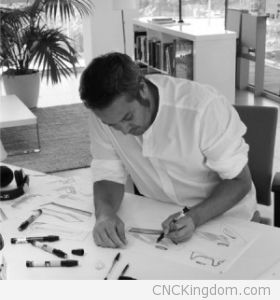 Nowadays and in terms of design, it’s hard to define a geographical area as easy as before and in this globalized world, opportunities and challenges are more or less the same for everyone… But, in my opinion, there are two particularly challenges and opportunities of the future.
Nowadays and in terms of design, it’s hard to define a geographical area as easy as before and in this globalized world, opportunities and challenges are more or less the same for everyone… But, in my opinion, there are two particularly challenges and opportunities of the future.
The first challenge that medium and small design firms have to face is the fast disappearing of traditional “fee for service”. The demand is progressively being covered in-house, by freelancers or the factories internal design teams due to the high fee costs. Let’s be clear, design demands are not declining, they are just requesting more services at lower prices.
Something that not everyone can afford. In that case, small businesses need to change their perspective and turn to the crowd-founding. Now it’s the prefect time for them to use all their creativity and experience on in-house projects and products, keeping it local and not depending on any client. Websites like Kickstarter are the perfect playground for small design and engineering teams. Obviously, success is not always the end result but at least it will keep your business busy and on the spotlight.
The second challenge is more like a global opportunity for freelancers. Today’s European crowded market place has lots of skilled designers fighting to stand out over the mass or get clients willing to outsource design. Now having a nice portfolio is not enough!
The key here is to turn the “globalized challenge” into an opportunity. European designers need to travel abroad to learn some of the American innovation, Chinese manufacturing or South American ingenuity; and in the way extend their portfolio, experience new ways of working, open their minds to global knowledge and, of course, look for those future “global clients”.

I really love your Inflow bathtub, what a great idea and it must be far more soothing having water falling from the side than from one side to keep the water at an even temperature. Where did this concept come from and how has it’s commercial success gone?
At the Roca Innovation Lab, I was lucky to be part of a great team of professionals that work together in each and every one of the projects, and as a team we came up with the idea or concept for the inflow than later was technically developed by Roca engineers and the Innovation Lab.
The idea was born as like many others at the Innovation Lab. We started researching and brainstorming on possible new wellness experiences but at the same time how to save water and energy, and after many months of research we were able to narrow down the concepts and ideas into one: the Inflow.
It’s a fact that a normal bathtub uses 300 liters per bath and only last warm for no more than 20 minutes. To solve that we create an ultra thin and long warm water blanket that immerses your body into a mix of warm water and air, consuming 75% less water. Consequently, we reduced the energy consumption by reducing the amount of water to be warmed.
As a secondary effect, in the process of recirculating and moving the water through the pipes we managed to maintain water temperature longer than regular bathtubs, extending the bathing experience to the max.
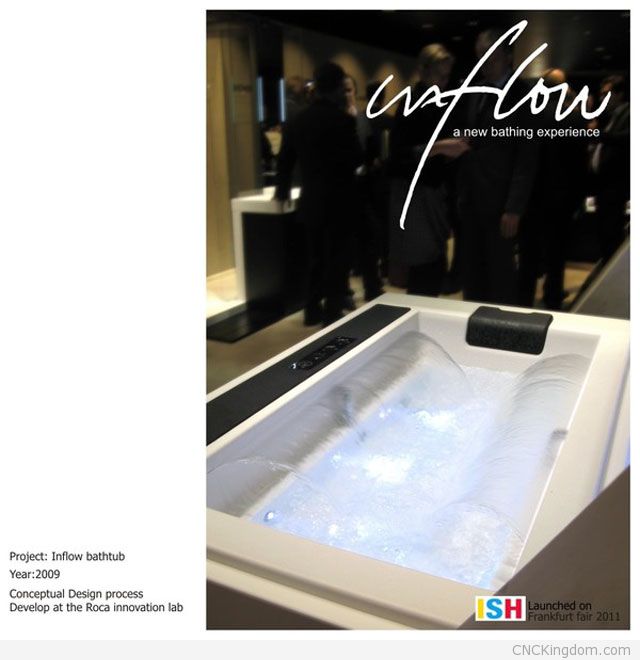


Your Rocket Bull bicycling is awesome… I really love this concept – something I’d love to ride myself! It’s quite a contrast in form and function to your Chopper Lobo. Which bike style do you prefer and what were some of the challenges coming-up with each for commercial production?
In regards to bikes, I have no preference for a specific style; I just love designing, sketching and modeling them. Rocket Bull and Lobo are just concepts, ideas or imaginative exercises in a subject that I am passionate about and, for now, I am not expecting to move forward to produce them. Nevertheless they were two good examples of what I can do in a “free design” zone were I was able to do what I want without restrictions or constrains… without a client I am able to explore different styles, sketching techniques, practice some 3D modeling but mostly, enjoy the time designing.
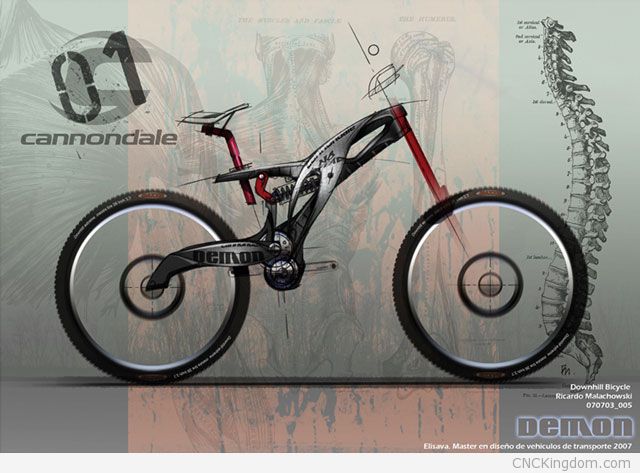
What CNC tools do you enjoy using the most (plasma, laser, router, 3d printer) and what are the software tools you use most often to help with your visualization and model testing?
I have no preference for a specific CNC tool. I think each project is different and each project has a more suitable tool for it. Some will be OK with a 3D printer others will need a laser… To choose one over the other you need to consider several factors like time, cost, quality, surface finishing, etc, etc…
To create a project I use Solidworks that also allows me to do “some” tests, but as a designer I never do final testing by myself; that’s a task for the experts on the matter. To visualize the product I use 3D max or Keyshot.
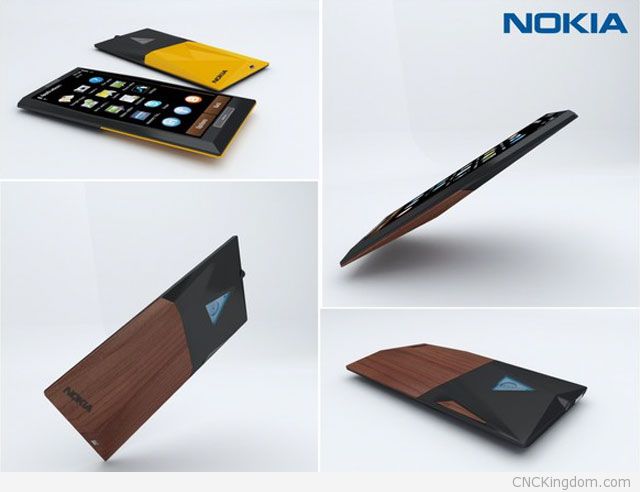
What are your views on 3D printers specifically? Do you think it’s a revolutionary tool that will take-over the design world or is it more hype than reality with very slow printing times and incredible expense.
3D printers, in my opinion, are not revolutionary tools… they were a natural consequence of more involved DIY projects and a bigger demand for better home tools… and in the same way they will evolve into better visualization and manufacturing tools.
I believe 3D printers will stay in the market for a long time and help develop new “local business and production runs” as there prices low down and there capabilities improve; but also will straggle to fight in that “visualization market” against the “new” technologies like holograms, 3D sketching or who knows what.
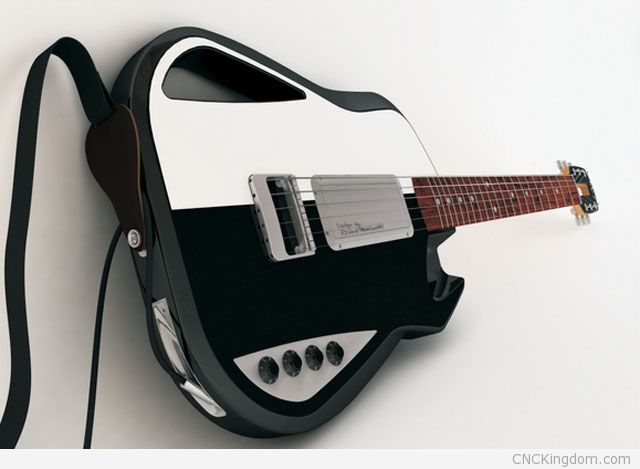
You spent most of your career in Europe and now work in China – how different is the working environment and expectations there by comparison?
How to start??? There is to much to say!… First, my opinion on the matter is based on personal experience and if someone gets offended, I am sorry is what I have encounter over the years…
Between Europe and China there are no points of comparison and better yet there is a huge contrast, in the good and the bad way. Let me explain, even when in general we could be talking about the same and the results are more or less the same: products! There are many differences:
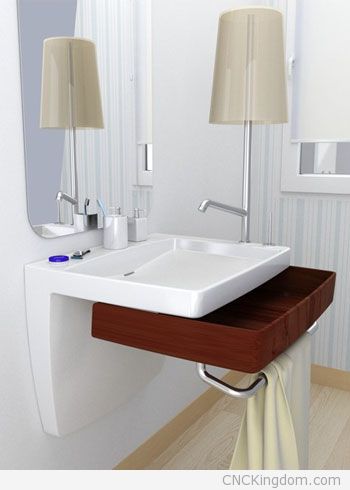 1- Design Initial approach
1- Design Initial approach
China works by demand, i.e. Designers do what they are asked for, no more!… sometimes less… They never question the petition or stop to reason why? They just do. On the opposite side, Europeans work by understanding. They always start by “thinking” why and how, some research, then questions, and more research until the basic knowledge of the project is clear… and then they start designing concepts.
Note: In my opinion, neither of those approaches is the best and every way has there time and moment.
2- Working environment
Once you overcome the cultural differences between Chinese and Westerners, there are not that many difference in the way work environments are set… Although, the good part of being a westerner here and let’s be honest, it’s the “Star” treatment you receive from your colleagues from time to time only for being from somewhere else.
3- Hunger
Is amazing how while Europe is debating between surviving the crisis and “keep it local”, Chinese companies and designer are hungry to prove they are capable of doing better and bigger than the rest of the world. As you see Europeans companies reducing cost and producing local, moving into more efficient and austere ways of working; Chines have no problem implementing latest technologies, expending in big open spaces, using all resources available, and do what ever it takes to accomplish what they want.
4- World care
Is a big problem that is not in the Chinese minds yet… Is changing at government levels but regular designers waste as like US designers. Paper and energy are seriously wasted here and projects have no perspective of being environmentally safe.
On the opposite side Europeans are more careful with waste and environmentally friendly projects or at list in their mind somehow.
